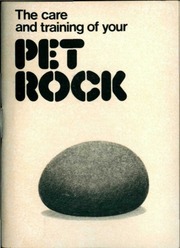The Pet Rock
The pet rock was a novelty item that gained immense popularity in 1975. It was the brainchild of Gary Dahl, an advertising executive from California. Dahl came up with the idea as a lighthearted joke and decided to package and sell rocks as pets.
The pet rock came in a cardboard box, resembling a pet carrier, complete with air holes, a bed of straw, and a humorous instruction manual. Each box contained a smooth river stone, which was meant to serve as the pet rock.
The concept behind the pet rock was that it required minimal care and offered the appeal of a low-maintenance "pet." Since rocks do not need feeding, grooming, or attention, it was a humorous and unconventional twist on the idea of pet ownership.
Despite its simplicity, the pet rock became a cultural phenomenon and enjoyed massive success. It captured the public's imagination and tapped into the humor and satire of the time. The pet rock's popularity was attributed to its novelty and the clever marketing campaign that surrounded it.
The Care and Training of Your Pet Rock
"The Care and Training of Your Pet Rock" was the humorous instruction manual that accompanied the pet rock when it was sold as a novelty item in 1975. The manual was designed to be tongue-in-cheek and played up the idea that a rock could be treated as a pet.
The manual provided a series of amusing instructions, tips, and guidelines for taking care of one's pet rock. Here are some highlights:
Feeding: The manual humorously mentioned that pet rocks do not require feeding. It suggested that if your pet rock appears hungry, you can try offering it treats like pebbles, but it warned that pet rocks might ignore the food.
Exercise: The manual suggested taking your pet rock for a walk. However, since rocks don't have legs, it humorously advised dragging your rock around the block or rolling it in a wheelbarrow.
Training: The manual comically explained that pet rocks are highly trainable and can learn to sit, stay, and roll over. It suggested using a stick or a motivational "word" to train your rock.
Grooming: The manual stated that pet rocks are naturally clean and require no grooming. However, it humorously recommended giving your rock an occasional bath or painting it to enhance its appearance.
Socialization: The manual recommended introducing your pet rock to other rocks to allow them to socialize and make rock friends. It humorously suggested arranging playdates for your pet rock.
Medical Care: The manual playfully mentioned that pet rocks are incredibly low maintenance and rarely get sick. In case of any issues, it suggested consulting a geologist.
The manual, along with its satirical advice, contributed to the whimsical and lighthearted nature of the pet rock phenomenon. It added to the overall appeal of the product and the humor surrounding the idea of owning a rock as a pet.
Take a look at the full "The Care and Training of Your Pet Rock" here at archive.org
While the pet rock fad eventually faded, it left a lasting impact on pop culture. It showcased the power of a simple, quirky idea that resonated with people's sense of humor. The pet rock remains a notable example of a short-lived yet highly successful novelty product from the 1970s.





Comments